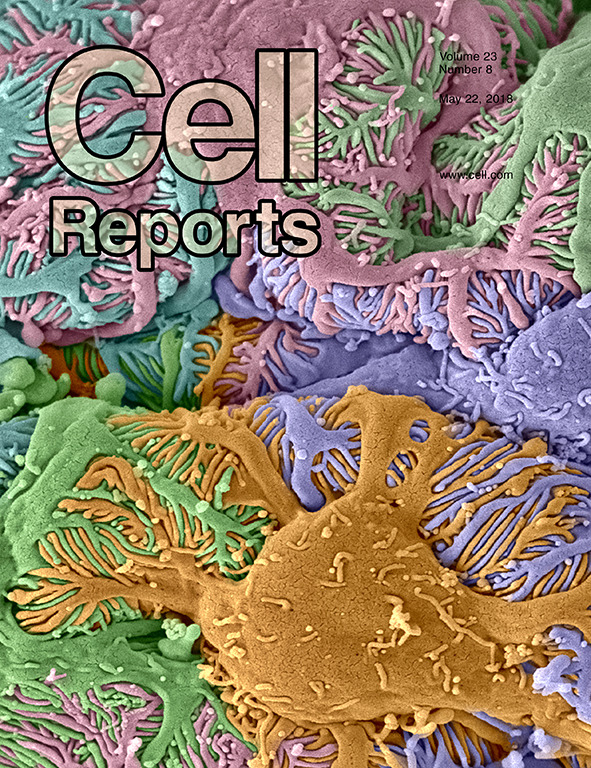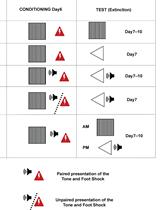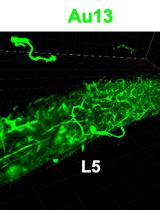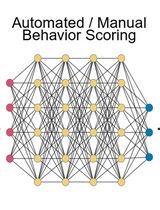- EN - English
- CN - 中文
Three-chamber Social Approach Task with Optogenetic Stimulation (Mice)
配有光遗传学刺激的三间隔社交途径测试(小鼠)
发布: 2018年12月20日第8卷第24期 DOI: 10.21769/BioProtoc.3120 浏览次数: 7245
评审: HSIU CHUN CHUANGDavid F DelotterieAnonymous reviewer(s)
Abstract
The formation of social relationships via social interactions and memory are essential for one’s physical and mental health. To date, rodent studies have used the three-chamber social approach test to measure social approach, social novelty, and social memory. In recent years, techniques including optogenetics have been developed to acutely control the activity of genetically defined populations of neurons. Recent studies have even combined optogenetics with advanced temporal gene expression control systems to label certain populations of neurons during learning and subsequently reactivated for memory testing. We combined optogenetic targeting with the three-chamber social approach test to examine particular neural circuits of interest during social memory encoding or retrieval. First, we stereotaxically infected specific brain areas with viral-encoding opsins that acutely activate or inhibit the firing of the neurons. Next, we subjected the mice to the three-chamber behavioral paradigm while delivering light during social memory encoding or retrieval. Lastly, the mice were tested with the delivery of light in a counter-balanced manner which allows each subject to be its own internal control. Thus, the optogenetic stimulation coupled with the three-chamber social approach test is a well-validated paradigm to explore the contribution of diverse brain circuits in various social cognition processes.
Keywords: Social approach (社交途径)Background
Social cognition is essential to our mental health. Deficits in social interaction and memory are hallmark characteristics in numerous brain disorders. Social working memory is an extremely dynamic process that is often unpredictable and requires constant adaptability to the changing stimuli (Lieberman, 2007). Specifically, it is a cognitive process that involves the encoding, storage, and retrieval of socially salient information. Traditional human and primate studies using imaging and lesion experiments, have implicated the medial temporal lobe in social cognitive tasks including social recognition and context evaluation (Insel and Fernad, 2004; Olson et al., 2013; Sandi and Haller, 2015). However, these previous studies employed toxins which caused extensive damage to broad areas in the brain and have limited the control of targeted cell types and subcellular compartments. Recent studies employing acute optogenetic approaches have implicated various brain regions and circuits, including the amygdala, hippocampus, and ventral tegmental area to play a critical role in the different facets of social behavior, including social interactions, approach, and discrimination memory (Felix-Ortiz and Tye, 2014; Gunaydin et al., 2014; Hitti and Siegelbaum, 2014; Okuyama et al., 2016).
To investigate the behavioral significance of a particular brain region in social memory processing, subject mice can be evaluated on their performance in a well-validated three-chamber social approach paradigm (Nadler et al., 2004). In this test, the subject mouse is habituated to the apparatus (stage 1). Then it is first introduced to a novel stranger mouse (S1) to evaluate memory formation and sociability (stage 2), and subsequently presented to a second novel stranger mouse (S2) to test social recognition memory and retrieval (stage 3). The amount of time the mouse spends investigating the stranger mice is recorded. Wild-type mice spend more time exploring a novel stranger mouse compared to a familiar conspecific. Therefore, combined with optogenetic targeting, specific neural circuits can be activated or inhibited during the various stages including memory formation (encoding) or retrieval (discrimination). Furthermore, the use of optogenetics can also identify particular genes in the neural circuits that may be involved in the regulation of sociability and/or social recognition memory in mice (Leung et al., 2018).
Materials and Reagents
- Filter paper
- Multimode fiber (0.39 NA, high OH, 200 μm Core, Wavelength range: 300-1,200 nm; ThorLabs, catalog number: FT200UMT)
- Materials for optogenetic experiments (Table 1)
- Multimode fiber (0.39 NA, high OH, 200 μm Core, Wavelength range: 300-1,200 nm; ThorLabs, catalog number: FT200UMT)
- 1.25 mm Ceramic Stick Ferrule, 230 μm (Precision Fiber Products, catalog number: MM-FER2007C-2000)
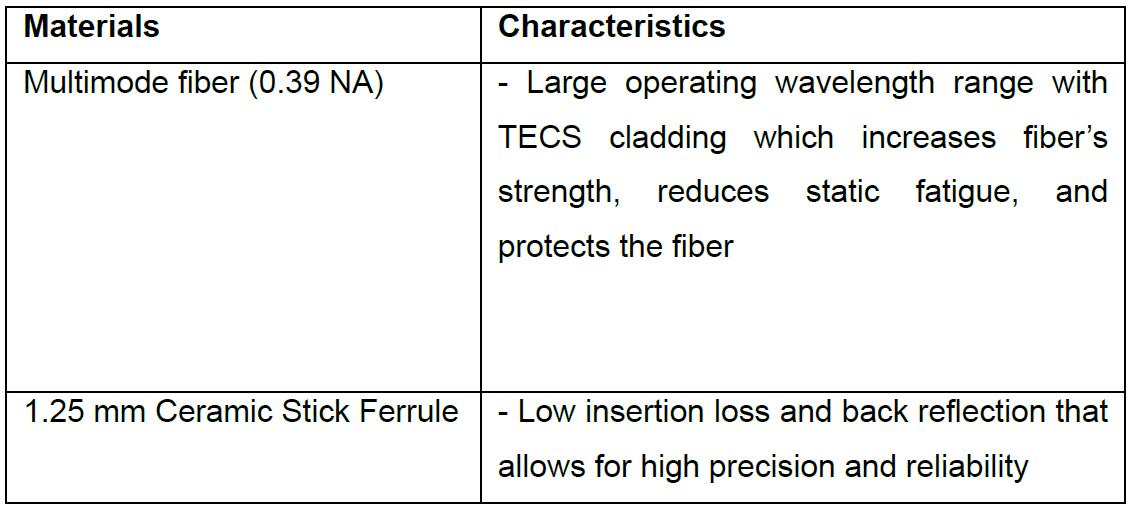
- Injection cannula (5 mm, 26 gauge; Plastics One, catalog number: C315GS-5/SPC)
- 1 ml Syringe (BD Sciences, catalog number: 309628)
- Tygon tubing 1/16” I.D. 1/8” O.D. and 1/32” wall (US Plastics, catalog number: 57102)
- Aluminum foil (Alcan)
Note: Ceramic ferrules was chosen over metal ferrules, to ensure accurate fiber alignment. - 1.25 mm SM Ceramic split sleeve, 6.60 mm Length (Precision Fiber Products, catalog number: SM-CS125S)
Note: Ceramic split sleeves were chosen over metal split sleeves, to ensure accurate fiber alignment. - 1.25 mm Ferrule dust cap, white (Precision Fiber Products, catalog number: BCDC-1300-W)
- Parafilm M (Pechiney Plastic Packaging, catalog number: PM-996)
- Cotton swab (The Lab Depot, catalog number: 394305)
- C57BL/6 mice (The Jackson Laboratory, catalog number: 000664)
Note: Male and female subjects (4 weeks+ old) and strangers (< 3 weeks old) have been successfully trained in this paradigm using this protocol. - AAV Viruses (stored at -80 °C until use with a titer of ~1011 to 1013 pfu/ml)
For example: AAV-CaMKIIα: eArchT3.0-EYFP (University of North Carolina GTC Vector Core)
AAV-CaMKIIa-hChR2 (H134R)-mCherry-WFRE-PA (University of North Carolina GTC Vector Core). - Dental cement (Stoelting Co., catalog number: 51458)
- Speed set instant mix epoxy (LePage, https://www.lepage.ca/en/lepage-products/build-things/epoxies/speed_set_instantmixepoxy.html)
- Suture kit (Ethicon, catalog number: JJ489)
- Tear gel (Novartis, https://well.ca/products/tear-gel-liquid-eye-gel_17561.html?gclid=CjwKCAjw6-_eBRBXEiwA-5zHaVuKltJxR7GYDuMwgeSM5yh_3J6FSiTehp0ekoUOvym2ICm3-YjZTxoCIkoQAvD_BwE)
- Betadine
- Saline
- 70% ethanol
- Hydrogen peroxide
- Ice
- Analgesics: Metacam (CDMV, 5 mg/ml one daily injection for three consecutive days)
Equipment
- Cleaver (Doric Lenses, catalog number: B600-0002)
- Fiber stripping tool (ThorLabs, catalog number: T12S21)
- 10 μl Pipette (SARSTEDT, catalog number: 90.1771.002)
- Digital Caliper (ULINE Canada)
- Mouse stereotaxic frame (Neurostar)
- Anesthesia system for isoflurane (Kent Scientific Corporation, catalog number: SOMNO-MSEKIT)
- Temperature controller (Sunbeam)
- Heating pad
- Surgical tools including scissors, forceps, scalpels (Fine Science Tools)
- 0.6 mm Drill bit connected to the stereotaxic frame (RWD Life Science, catalog number: 78001)
- Two-syringe infusion pump (World Precision Instruments, catalog number: SP200iZ)
- 10 μl Hamilton Gastight syringe (Hamilton, catalog number: 84875)
- White noise machine (Marpac)
- Fiber cable, MM, 200 μm, 0.39 NA, FC/PC-FC/PC (Thorlabs, catalog number: M72L02)
- Equipment for optogenetic experiments (Table 2)
- 473 nm DPSS Laser system (Laserglow, catalog number: R471003GX)
- 532 nm DPSS Laser system (Laserglow, catalog number: R531003GX)
- Function/arbitrary waveform generator (BK Precision, catalog number: 4052)
Table 2. Summary of the main characteristics of the equipment used for optogenetic experiments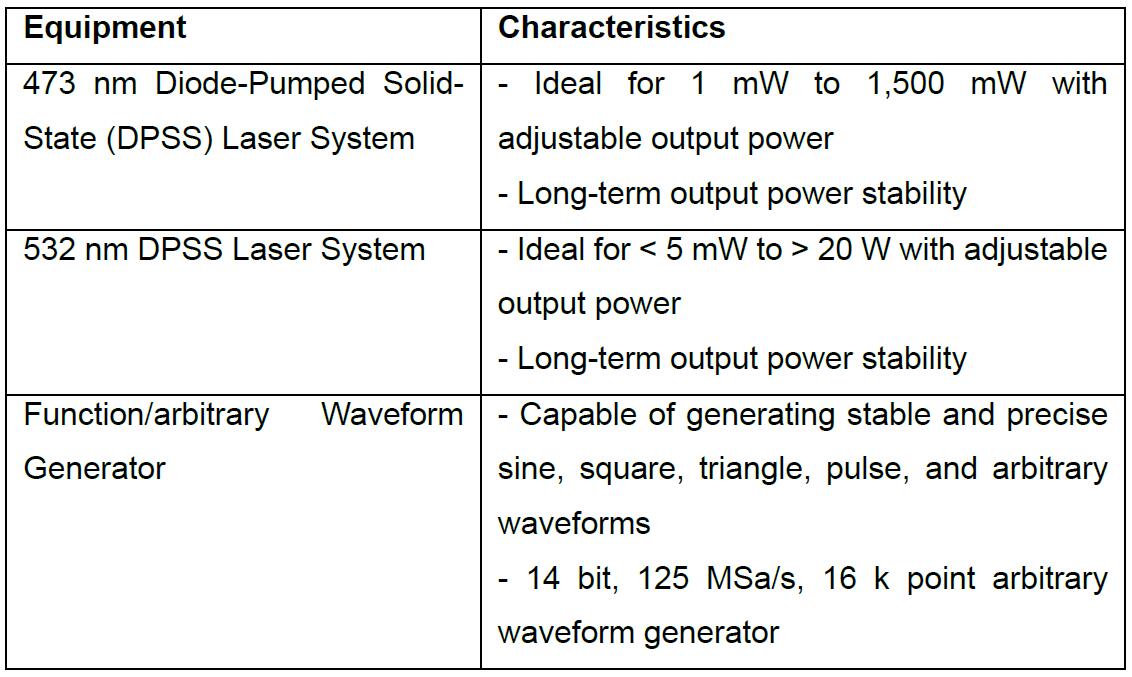
- Power meter, Si sensor, 400-1,100 nm, 500 nW-500 mW (ThorLabs, catalog number: PM121D)
- Laser Glasses, 180-532 nm (ThorLabs, catalog number: LG3)
- Doric mini cube (Doric Lenses, catalog number: B340-0204)
- 2 Mono fiberoptic patch cords (Doric Lenses, catalog number: D202-2302)
- 45 cm wide x 20 cm long x 30 cm high three-chamber apparatus (ANY-maze)
- 8 cm diameter x 17 cm high cylindrical wire cage (ANY-maze)
- Autoclave
Software
- ANY-maze tracking software (Stoelting Co., http://www.anymaze.co.uk/)
Procedure
文章信息
版权信息
© 2018 The Authors; exclusive licensee Bio-protocol LLC.
如何引用
Leung, C., Kim, J. C. and Jia, Z. (2018). Three-chamber Social Approach Task with Optogenetic Stimulation (Mice). Bio-protocol 8(24): e3120. DOI: 10.21769/BioProtoc.3120.
分类
神经科学 > 行为神经科学 > 学习和记忆
神经科学 > 神经系统疾病 > 动物模型
您对这篇实验方法有问题吗?
在此处发布您的问题,我们将邀请本文作者来回答。同时,我们会将您的问题发布到Bio-protocol Exchange,以便寻求社区成员的帮助。
提问指南
+ 问题描述
写下详细的问题描述,包括所有有助于他人回答您问题的信息(例如实验过程、条件和相关图像等)。
Share
Bluesky
X
Copy link


